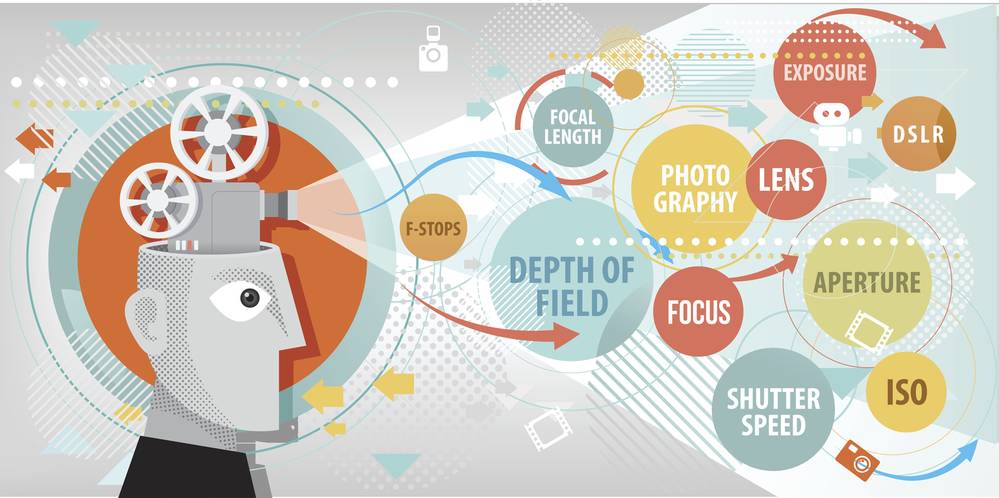Here is a little guide for basic photography terms for beginners. On the road of your learning photography journey, these key terms will help you master the art easily.
You can pin or save this list as a reference for later or when you have a question. It is always good to have a reference to come back to when you are stuck.
For full glossary of photography terms please refer to GuidetoCamera website.
Basic Photography Terms for Beginners:

Aperture
The adjustable opening—or f-stop—of a lens determines how much light passes through the lens on its way to the surface of the camera’s imaging sensor. “Faster” lenses have wider apertures, which in turn allow for faster shutter speeds. The wider the aperture is set, the shallower the depth of field will be in the resulting image.
Aspect Ratio
Aspect ratio refers to the shape, or format, of the image produced by a camera. Many digital cameras offer the option of switching between 4:3, 3:2, or 16:9.
Bokeh
Pronounced boh-keh, it refers to the out-of-focus areas in a photograph with limited depth of field, particularly around, but not limited to, the highlight areas. Bokeh appears as little circles in the unsharp areas. Depending upon the shape of the opening formed by the blades of the lens’s aperture, the circles appear either more or less circular.
Bracketing
Bracketing involves taking multiple images of the same scene, usually in 1/3, 1/2, or full-stop increments, to create a choice of exposure options.
Chromatic Aberration
Also known as color fringing, chromatic aberration occurs when the collective color wavelengths of an image fail to focus on a common plane. The results of chromatic aberration are most noticeable around the edges of high-contrast images, especially toward the edges of the frame. Chromatic aberration is most common on less expensive lenses, although even the best optics can occasionally display lower levels of chromatic aberration, under certain conditions.
Color Space
The range of colors that can be reproduced on a computer monitor or in print. The most commonly used color spaces for digital imaging are the baseline sRGB and wider-gamut Adobe RGB (1998).
Composition
The arrangement of subject matter, graphic elements, tones, and light in a scene. There are no set rules, just suggestions; successful compositions are ones that best express particular feelings about the subject or scene.
Depth of Field
Literally, the measure of how much of the background and foreground area before and beyond your subject is in focus. Depth of field can be increased by stopping the lens down to smaller apertures. Conversely, opening the lens to a wider aperture can narrow the depth of field.
Diffuser
Any device that diffuses or spreads out or scatters light in some manner, to give soft light.
DSLR
A single lens reflex (SLR) camera that captures digital images. It includes a camera body with interchangeable lenses.
Exposure
Exposure is the phenomenon of light striking the surface of film or a digital imaging sensor. The exposure is determined by the volume of light passing through the lens aperture (f/stop) combined with the duration of the exposure (shutter speed).
Focal Length
The distance from the lens to the film plane or sensor that focuses light at infinity. The length, expressed in millimeters, is more useful as an indication of the angle of view of a particular lens. A shorter focal length lens, such as a 28mm, offers a wider angle of view than a longer one, such as 100mm.
HDR
High Dynamic Range (HDR) technique used in imaging and photography to reproduce a greater dynamic range of luminosity than is possible with standard digital imaging or photographic techniques. The aim is to present a similar range of luminance to that experienced through the human visual system. The human eye, through adaptation of the iris and other methods, adjusts constantly to adapt to a broad range of luminance present in the environment. The brain continuously interprets this information so that a viewer can see in a wide range of light conditions.
Highlights
The brightest parts of a scene that yield texture or image information. A spectral highlight is pure light and will print as “paper” white.
Histogram
A visual representation of the exposure values of a digital image. Histograms are most commonly illustrated in graph form by displaying the light values of the image’s shadows, midtones, and highlights as vertical peaks and valleys along a horizontal plane. When viewing a histogram, the shadows are represented on the left side of the graph, highlights on the right side, and midtones in the central portion of the graph.
ISO
International Organization of Standardization. A number indicating an image sensor’s (or film’s) sensitivity to light. The higher the number, the more sensitive and faster the sensor (or film) is. Although traditional cameras don’t have a specific ISO rating, digital cameras do as a way to calibrate their sensitivity to light. ISO is equivalent to the older ASA. Most digital cameras have native (basic) ISO ratings of about 100, but can be “extended” far beyond this base rating in order to capture sharp imagery under lower lighting conditions. When shooting at extended ISO levels, image quality begins to suffer in terms of sharpness levels, noise, contrast, and added “graininess.”
JPEG
The standard for image compression in digital imaging devices. JPEG is a “lossy” compression format, capable of reducing a digital image file to about 5% of its normal size. The resulting decompression of the file can cause “blockiness,” “jaggies,” or “pixelization” in certain digital images. The greater the compression levels, the more of a chance pixelization or “blockiness” will occur. The greater the pixel count, the less of a chance pixelization will occur.
Manual Mode
Manual mode allows the photographer to set the exposure instead of having the camera do it automatically. In manual, you choose the aperture, shutter speed and ISO, and those choices affect how light or dark the image is. Semi-manual modes include aperture priority (where you only choose the aperture), shutter priority (where you only choose the shutter speed) and programed auto (where you choose a combination of aperture and shutter speed together instead of setting them individually). Manual can also refer to manual focus, or focusing yourself instead of using the autofocus.
Megapixel
A megapixel contains 1,000,000 pixels and is the unit of measure used to describe the size of the sensor in a digital camera.
Metering
A light meter built into the camera helps guide decisions, indicating if the camera thinks the image is over or under exposed. Metering is actually based on a middle gray, so having lighter or darker objects in the image can throw the metering off a little bit. Metering modes indicate how the meter is reading the light. Matrix metering means the camera is reading the light from the entire scene. Center-weighted metering considers only what’s at the center of the frame and spot metering measures the light based on where your focus point is.
Mirrorless Camera
A mirrorless interchangeable lens camera (MILC) is a digital camera with an interchangeable lens and uses an image sensor to provide an image to a rear display and/or an electronic viewfinder (EVF). It is called mirrorless since it does not have a mirror in the optical path.
Negative Space
The area which surrounds the main subject in your photo (the main subject is known as the “positive space”). Also known as white space or empty space.
Noise
A common problem of digital photography, noise is the appearance of color artifacts in a digital image. Mostly noticeable in the shadow areas of images captured at higher ISO ratings, the image processors used in many current digital cameras utilize noise-suppression software to minimize the appearance of noise artifacts. Heat build-up due to continuous shooting in hot environments can also cause noise artifacts within digital images. Noise is considered the digital version of grain in film negatives.
Orientation
In photography, orientation refers to the way you take and display your photographs. The vast majority of photographs from DSLR and point-and-shoot cameras are taken with a ‘landscape’ or horizontal orientation, where the photograph is longer than it is tall, while the advent of cell phone cameras and sites like Pinterest have helped bring attention to the less common ‘portrait’ or vertical orientation, where a photograph is taller than it is wide. Even the terms that we use to refer to this orientations – landscape and portrait – imply that some subjects are better suited to one orientation than another.
RAW Files
Many pro and semi-pro digital cameras include the option for capturing raw files, which—unlike JPEGs, TIFFs, and other file formats—contain all of the data captured during the exposure in an unedited format. When processed, raw files can be adjusted far more extensively than images captured in other imaging formats, and can be saved as JPEGs, TIFFs, etc. The original raw file remains unaltered and can be reprocessed at any time for other purposes.
Reflector
A device that is used to reflect light, generally back towards the subject. It can be a specialized factory made reflector or as simple as a piece of white cardboard.
Rule of Thirds
This compositional rule suggests imagining the image has been divided into three parts both horizontally and vertically. Often the most interesting compositions result in placing the subject on one of the intersections of those imaginary lines, instead of in the center of the photo.
Shutter Speed
The length of time the shutter remains open when the shutter release is activated, most commonly expressed in fractions or multiples of a second.
Vignetting
Darkening of the edges of a photographic image due to the inability of a lens to evenly distribute light to the corners of the frame. While correctable with filtration using on-camera, center-weighted neutral density filters, or electronically in Photoshop, vignetting is often valuable as a creative device to direct the eye back to the center of the frame.
White Balance
The camera’s ability to correct color cast or tint under different lighting conditions including daylight, indoor, fluorescent lighting, and electronic flash. Also known as “WB,” many cameras offer an Auto WB mode that is usually—but not always—quite accurate.
